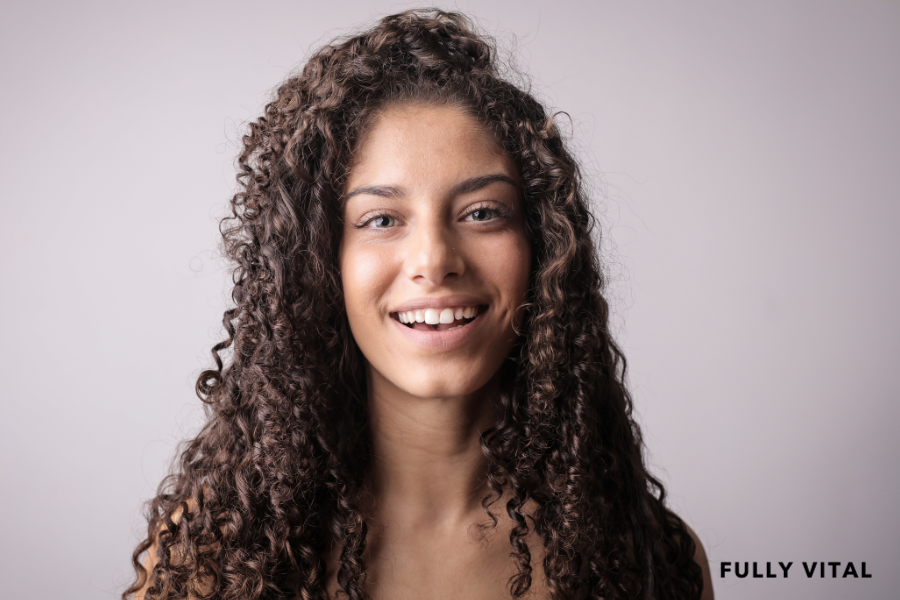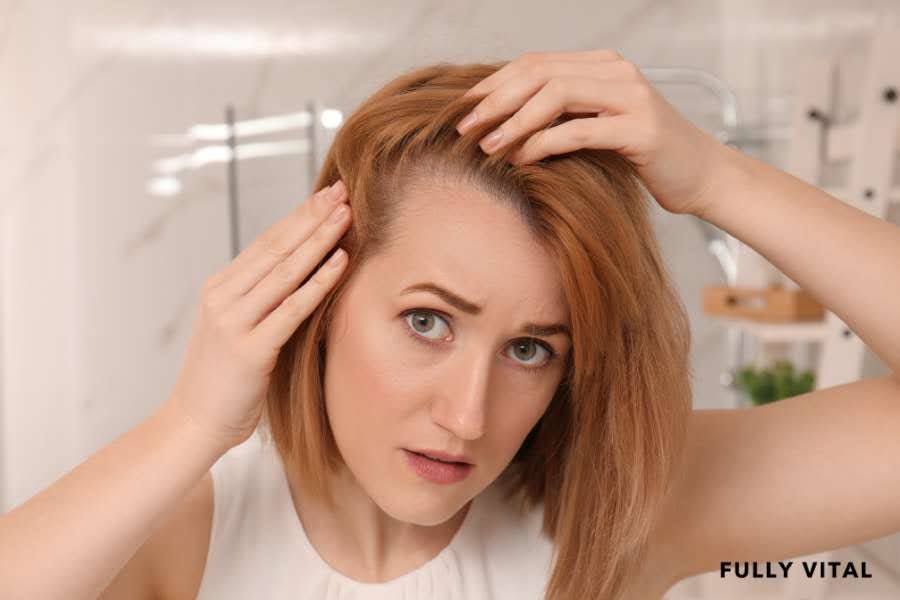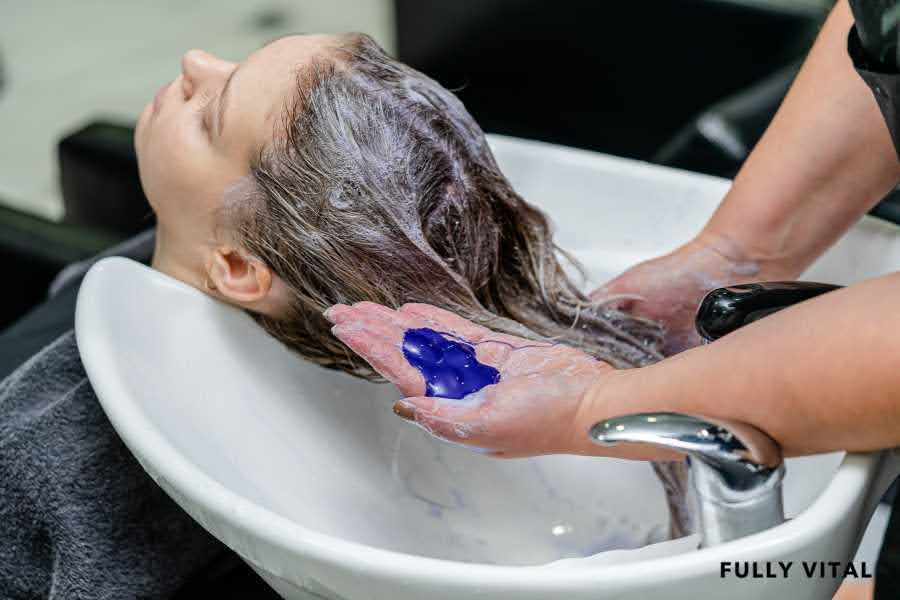
How To Use A Hair Texture Chart For Perfect Styling | Complete Guide
A hair texture chart is an essential tool for identifying your hair type, essential for tailoring your hair care and styling routine.
At Fully Vital, we are dedicated to helping you maintain a vibrant and healthy hair relationship, offering products that promote hair growth and rejuvenation.
Get to know your hair's texture with our guide to using a hair texture chart, and unlock your hair's full potential every day.

I LOVE MY HAIR NOW
FullyVital hair serum and hair vitamins made tremendous improvements in my hair. I truly love my hair now.
Dorit S.,
Understanding The Importance Of A Hair Texture Chart
A hair texture chart is crucial for understanding your hair's unique type, much like knowing your clothing size for the perfect fit.
It reveals your hair's texture, from straight to coily, and details like strand thickness and moisture retention.
Armed with this knowledge, you can choose the right Fully Vital products for growth and care, ensuring your hair always looks its best.
Identifying Different Types Of Hair Textures
So, how do you figure out where your hair fits on the texture chart? It's like being a detective, but for your hair.
Let's break it down into simple steps so you can identify your hair texture without a hitch.
First things first, wash your hair and let it dry without adding any products.
This way, you're looking at your hair in its natural state.
Here's what to look for:
Straight Hair
If your hair lies flat from roots to tips, it's straight.
Straight hair is divided into three types:
- Type 1A: Super fine and soft; it's hard to hold a curl.
- Type 1B: Has a bit more body and volume than 1A.
- Type 1C: Thick and coarse; it might have a slight wave.
Wavy Hair
Wavy hair is like the beachy middle ground between straight and curly.
It's got three categories as well:
- Type 2A: Fine, with a loose, tousled texture.
- Type 2B: Medium thickness with more defined waves.
- Type 2C: Thick and prone to frizz, the waves start right from the roots.
Curly Hair
Curly hair is full of loops and spirals. It's fun, bouncy, and vibrant, just like your personality might be:
- Type 3A: Loose curls with a shiny, well-defined S-shape.
- Type 3B: Medium amount of curl, from bouncy ringlets to tight corkscrews.
- Type 3C: Dense, tight curls; often called "corkscrews."
Coily Hair
Coily hair features tight curls and lots of volume.
Coily hair has its own system:
- Type 4A: Soft, fine, tightly coiled.
- Type 4B: Has a more zig-zag pattern than a defined curl.
- Type 4C: Very tight zig-zag pattern; coily hair might not have as much natural shine.

How To Use A Hair Texture Chart: A Step-By-Step Guide
Once you've figured out your hair texture, you're probably wondering, "What now?" It's time to put that knowledge to practical use.
With these steps, you'll be able to leverage a hair texture chart for perfect styling and hair care.
Analyze Your Hair's Natural State
Look at your hair without any styling products or heat treatment.
Use the hair texture chart to determine where your hair falls in terms of curl pattern, strand thickness, and overall texture.
Determine Your Hair's Porosity
Porosity is about how well your hair can absorb and hold moisture.
You can do a simple test by dropping a strand of hair into a glass of water.
If it floats, you have low porosity (resistant to moisture).
If it sinks quickly, you have high porosity (absorbs moisture fast but loses it just as quick).
Match Your Texture to Hair Care Products
Now that you know your hair's texture and porosity, you can select products designed for your hair type.
Look for shampoos, conditioners, and styling products specifically formulated for your hair texture to promote hair growth and enhance its natural beauty.
Choose the Right Styling Tools and Techniques
Using the hair texture chart as a guide, pick styling tools and methods that work well with your hair type.
For example, if you have tightly coiled hair, use a wide-tooth comb for detangling.
If you have wavy hair, a diffuser on your blow dryer can help maintain your waves.
Experiment With Recommended Hairstyles
Each hair texture can carry certain styles better than others.
Discover what hairstyles are often recommended for your hair type and experiment with them.
Embrace your hair's natural texture and try styles that enhance it.
Adjust Your Hair Care Routine Accordingly
Revise your hair care routine based on what you've learned.
For instance, if you have dry and coarse hair, incorporating deep conditioning treatments into your routine might help.
If your hair is fine and oily, you may need to wash it more frequently with a gentle, volumizing shampoo.

The Role Of Genetics In Determining Hair Texture
When we talk about hair texture, it's important to take a moment to acknowledge the role that genetics play in determining how our hair looks and behaves.
It's like a secret recipe passed down through generations that makes your hair uniquely yours.
Your DNA holds the blueprint for your hair's texture, curl pattern, thickness, and even how much shine it has.1
If you've ever wondered why your hair is curly while your best friend's is pin-straight, it's all written in your genetic code.
Picture it like this: If both of your parents have curly hair, the chances are you're going to have curls too.
That's because the genes for curly hair are pretty strong.
However, it gets interesting when you have a mix of hair textures in your family tree.2
You might inherit a combo of traits that give you a unique texture that's just a little curly or wavy - sort of a blend of both your mom's and dad's hair types.3
But genes aren't the only factor here.
Your ethnicity and race also influence your hair's texture.
People of African descent tend to have coily or tightly curly hair, while Asian people often have straight hair.
Those of European descent can have a whole range of textures from straight to curly.
Hair Texture And Hair Care: Establishing A Routine
Establishing a hair care routine tailored to your hair's texture is kind of like creating a personal training program for your locks.
Just as different body types require different exercise regimens, different hair textures need specific types of care to look and feel their best.
But how do you build a routine that's just right for you? It's about more than just deciding on curly vs. straight or thick vs. thin.
It's about crafting a day-by-day plan that nurtures your hair from root to tip.
Here's how to get started:
Start with the Basics: Shampoo and Conditioner
Your shampoo and conditioner are the foundation of your hair care routine.
If you have fine, straight hair, you might need a volumizing shampoo to give your locks a lift.
Got curly hair?
A hydrating conditioner is your best friend to keep those spirals bouncy and full of life.
When you're picking out these products, always keep your hair texture chart in mind.
It'll point you to the right ingredients that your particular type of hair needs to thrive.
Add in Special Treatments: Masks and Oils
No matter your hair type, a little extra love can go a long way.
Treatments like hair masks or oils can be like a spa day for your strands.
If you've got coarse or dry hair, a deep conditioning mask once a week can work wonders.
Lightweight oils or leave-in conditioners are a hit for keeping wavy or curly hair moisturized throughout the day without weighing it down.
Don't Forget Protection: Heat Protectors and UV Shields
Heat styling tools can be the enemy if used too frequently, especially on delicate hair types.
Always use a heat protectant spray or serum before you apply any heat to your hair.
And if you're out in the sun a lot, consider products with UV protection to keep your hair color from fading and to prevent dryness.
Regular Trims: Keeping Ends Healthy
Split ends don't discriminate.
They can happen to anyone, regardless of hair texture.
Regular trims are essential to keep your hair looking neat and healthy.
For most hair types, every 6-8 weeks is a good rule of thumb, but your texture may mean you can go a bit longer between salon visits.
Tailor Your Technique: Combing and Styling
The tools and techniques you use should complement your hair's natural texture. Wide-tooth combs or brushes with natural bristles are usually kinder to your hair than metal or plastic.
And when it comes to styling, work with your hair's natural tendencies.
Enhance your waves with a diffuser, or use a silk pillowcase to keep your straight hair smooth as you sleep.
Trial and Error: Adjusting as You Go
A hair care routine isn't set in stone.
Your hair's needs can change with the seasons, as you age, or even with your health.
Pay attention to how your hair responds to different products and techniques, and don't be afraid to change things up if something isn't working.
Discover The Secret To Youthful, Vibrant Hair With Fully VitalAre you ready to revolutionize the way you care for your hair? With Fully Vital's advanced hair growth products, you can tap into the power of our scientifically formulated products to not just stop but reverse the signs of hair aging. Experience the transformation and nurture a healthier relationship with your locks:
If you're ready to embrace the full potential of your hair's health and appearance, the solution is at your fingertips. Harness the benefits of dedicated research and natural power with Fully Vital's innovative hair growth collection. Don't let hair aging shadow your confidence. Make the commitment to your hair's longevity and vitality now – because you deserve a crown of hair that's as young and vibrant as you feel inside. Nourish, Protect, and Revive – with Fully Vital. |
Final Thoughts On Hair Texture Chart
Your hair is your crowning glory, and knowing how to treat it right starts with understanding what type of texture you're working with.
A hair texture chart isn't just a guide; it's the secret to unlocking your hair's full potential.
By identifying your hair's unique characteristics and adopting a care and styling routine that's tailored to its needs, you can help your hair stay youthful, vigorous, and simply stunning.
Don't forget, your hair's texture is a beautiful part of who you are, influenced by genetics but also adaptable to the care you provide.
As you use the wisdom of the hair texture chart, remember that every hair type is beautiful and deserving of love and the right care – that's where Fully Vital steps in.
Keep experimenting and adjusting your hair care routine until you find what makes your locks truly happy.
Whether it's the products from our range designed to enhance hair growth and vitality, or the perfect styling method that you've discovered, embrace your hair's authenticity.
Let the care you put into your hair be a reflection of the care you put into yourself.
Check out our recent blogs:
- Understanding Hair Breakage: Causes, Effects, And Solutions For Healthy Hair Growth
- Butylene Glycol: Importance In Haircare
- Citric Acid For Hair
Frequently Asked Questions About Hair Texture Chart
Why is using a hair texture chart essential in styling?
Using a hair texture chart is key because it helps you understand your hair type better.
This way, you can pick the styles, products, and tools that work best for your hair.
It's kind of like having a map before starting a journey – it guides you in the right direction.
Can a hair texture chart help in choosing the best hair style?
Yes, it can! A hair texture chart takes away the guesswork.
It can show you what styles might look amazing on your type of hair.
By knowing your hair texture, you can also avoid styles that won't work as well or might damage your hair.
Who can use a hair texture chart?
Anyone! Whether you're just learning how to take care of your hair or you've been styling it for years, a hair texture chart is a super useful tool.
It's for women of all hair types who want their hair to look its best.
Do professionals use hair texture charts?
Absolutely, hair stylists and other hair pros often use texture charts.
They are tools of the trade for pinpointing exactly what type of hair they are working with, which helps them create the best look for their clients.
How accurate is a hair texture chart?
A hair texture chart is quite accurate when it comes to categorizing hair types.
However, remember that each person's hair is unique.
So while charts are helpful, they may not capture every single feature of your hair.
Does my ethnicity influence my position on the hair texture chart?
It might.
Different ethnicities can have common hair texture characteristics.
But it's important not to generalize too much because there is a lot of variation within ethnic groups.
Your specific hair texture matters more than your ethnicity.
What are the different categories in a hair texture chart?
Usually, hair texture charts split hair types into four main categories: straight, wavy, curly, and kinky.
Each of these categories may have subcategories to describe how tight a curl is or how thick the hair strands are.
Where can I find a useful hair texture chart?
You can find hair texture charts online, in beauty magazines, or at hair salons.
Sometimes they come as part of a product's packaging, especially products that are made for specific hair types.
Can I determine my hair texture type without a chart?
You might be able to guess it, but having a hair texture chart makes it so much easier and more accurate.
It puts visuals to words and gives a clear way to classify your hair.
How often should I use a hair texture chart to evaluate the health of my hair?
You don't need to use a hair texture chart often to check on your hair's health.
It's more of a one-time tool to figure out your hair type.
Once you know that, you can focus on proper hair care and the products from Fully Vital to keep your hair looking fantastic and healthy.
Sources:
- MedlinePlus. (n.d.). Is hair texture determined by genetics? Retrieved from https://medlineplus.gov/genetics/understanding/traits/hairtexture/
- Sample, I. (2016, March 1). Combing human genome reveals roots of hair diversity. The Guardian. Retrieved from https://www.theguardian.com/science/2016/mar/01/combing-human-genome-reveals-roots-of-hair-diversity
- Loussouarn, G., Garcel, A. L., Lozano, I., Collaudin, C., Porter, C., Panhard, S., Saint-Léger, D., & de La Mettrie, R. (2019). High-throughput phenotyping methods for quantifying hair fiber curvature. Scientific Reports, 9, 7950. https://doi.org/10.1038/s41598-021-90409-x







